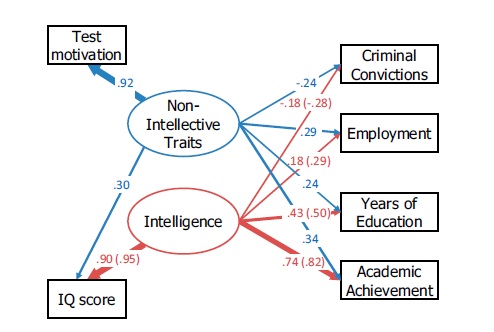IQ tests, in their ideal form, accurately measure intelligence.
In the real world, they don't, for several reasons.
First, many portions of an IQ assessment test crystallized knowledge – that is, they test for facts that have already been memorized. Although knowledge is a component of intelligence, intelligence, as it is usually used, means, ‘how fast can this person learn?'
The Ravin's Progressive Matrix overcomes a part of that problem by eliminating all words – allowing anyone of any culture of any reading level to complete the test.
There are still a few problems.
First, performance on these tests can be trained, much like how performance on the SAT can be trained and improved, even while the base level of knowledge does not increase.
Second, a number of personality factors influence how hard a person tries, in turn influencing their score.
This study wished to quantify the role of test motivation on test performance. Those participants who were incentivized to try hard (with money, candy, etc…) did better – incentives increased the IQ scores of individuals with below-average IQs at baseline by .96 SD, and .26 SD for individuals with above-average IQs at baseline. .96 standard deviations is huge – corresponding to 10 to 15 IQ points.
The fact that incentives made less difference for those with higher baseline IQ suggests that part of the reason they have a higher baseline IQ is that they can generate more intrinsic motivation, causing them to exert greater than average effort. That, in turn, suggests that the true spread of intelligence is more narrow than what the standard distribution suggests.
Click here to learn more about self-control.
Study Details
Hypothesis: Test motivation partially explains variance in IQ scores, which in turn can be partially explained by non-intelligence factors. This suggests the additional hypothesis that test motivation inflates the predictive value of IQ.
Study 1: Across 46 independent samples, 2,008 subjects were assigned to one of two conditions – taking an IQ test under normal circumstances or taking an IQ test while being materially incentivized (e.g. money, candy, etc…) to put forth the maximal effort.
Incentives increased the IQ scores of individuals with below-average IQs at baseline by .96 SD, and .26 SD for individuals with above-average IQs at baseline. This suggests that the true distribution of intelligence is more narrow and that those with high IQ are closer to performing near their maximum.
Study 2: 251 boys part of a longitudinal study completed an IQ test while being recorded by video. Slices of this video were later observed by coders, who then rated the level of test motivation displayed by the boys on a 4-point scale. In young adulthood, the boys returned to complete a number of questions which could be used to indicate how well they were doing in life.
Nonintellective traits, which was estimated using test motivation, explained part of the predictive power of IQ.
The model used to explain the contribution of nonintellective traits and intelligence to IQ, test motivation, and life outcomes can be visualized as below:
Concerns: The entire sample of study 2 was male.
Questions: What exactly are the nonintellective traits involved? What are their individual contributions?
Duckworth, A. L., Quinn, P. D., Lynam, D. R., Loeber, R., & Stouthamer-Loeber, M. (2011). Role of test motivation in intelligence testing. Proceedings of the National Academy of Sciences, 108(19), 7716-7720.


